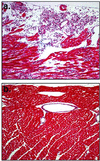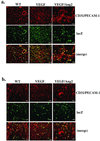Orchestration of angiogenesis and arteriovenous contribution by angiopoietins and vascular endothelial growth factor (VEGF)
- PMID: 12048246
- PMCID: PMC123048
- DOI: 10.1073/pnas.122109599
Orchestration of angiogenesis and arteriovenous contribution by angiopoietins and vascular endothelial growth factor (VEGF)
Abstract
Multiple classes of factors contribute to angiogenesis. In past years, the primary focus has been to understand the functions of individual classes of angiogenic factors. However, few studies have focused on the combinatorial roles of multiple classes of factors in angiogenesis. In this report, we have investigated the in vivo angiogenic processes regulated by two major classes of angiogenic factors, the angiopoietins and vascular endothelial growth factor (VEGF). Here we show that angiopoietin-1, a factor previously considered to be proangiogenic, can offset VEGF-induced angiogenesis in vivo. We also provide direct in vivo evidence for the synergistic effect of angiopoietin-2 and VEGF on the induction of angiogenesis. Furthermore, we show that these two classes of factors control the ratio of arterial and venous blood vessel types during angiogenesis. We believe that our study is a step toward understanding how multiple classes of factors harmonize angiogenesis and blood vessel types.
Figures




Similar articles
-
[Angiogenic inducers and inhibitors].Tanpakushitsu Kakusan Koso. 2000 Sep;45(13 Suppl):2131-8. Tanpakushitsu Kakusan Koso. 2000. PMID: 11021214 Review. Japanese. No abstract available.
-
Vascular endothelial growth factor and the angiopoietins: working together to build a better blood vessel.Circ Res. 1998 Aug 10;83(3):342-3. doi: 10.1161/01.res.83.3.342. Circ Res. 1998. PMID: 9710128 No abstract available.
-
Increased vascularization in mice overexpressing angiopoietin-1.Science. 1998 Oct 16;282(5388):468-71. doi: 10.1126/science.282.5388.468. Science. 1998. PMID: 9774272
-
New model of tumor angiogenesis: dynamic balance between vessel regression and growth mediated by angiopoietins and VEGF.Oncogene. 1999 Sep 20;18(38):5356-62. doi: 10.1038/sj.onc.1203035. Oncogene. 1999. PMID: 10498889 Review.
-
Tumor-derived vascular endothelial growth factor up-regulates angiopoietin-2 in host endothelium and destabilizes host vasculature, supporting angiogenesis in ovarian cancer.Cancer Res. 2003 Jun 15;63(12):3403-12. Cancer Res. 2003. PMID: 12810677
Cited by
-
Kaposi's sarcoma-associated herpesvirus promotes angiogenesis by inducing angiopoietin-2 expression via AP-1 and Ets1.J Virol. 2007 Apr;81(8):3980-91. doi: 10.1128/JVI.02089-06. Epub 2007 Feb 7. J Virol. 2007. PMID: 17287278 Free PMC article.
-
Targeting the Tie2/Tek receptor in astrocytomas.Am J Pathol. 2004 Feb;164(2):467-76. doi: 10.1016/S0002-9440(10)63137-9. Am J Pathol. 2004. PMID: 14742253 Free PMC article.
-
An anthelmintic drug, pyrvinium pamoate, thwarts fibrosis and ameliorates myocardial contractile dysfunction in a mouse model of myocardial infarction.PLoS One. 2013 Nov 4;8(11):e79374. doi: 10.1371/journal.pone.0079374. eCollection 2013. PLoS One. 2013. PMID: 24223934 Free PMC article.
-
Divergent regulation of angiopoietin-1 and -2, Tie-2, and thrombospondin-1 expression by estrogen in the baboon endometrium.Mol Reprod Dev. 2010 May;77(5):430-8. doi: 10.1002/mrd.21163. Mol Reprod Dev. 2010. PMID: 20140967 Free PMC article.
-
Context-dependent role of angiopoietin-1 inhibition in the suppression of angiogenesis and tumor growth: implications for AMG 386, an angiopoietin-1/2-neutralizing peptibody.Mol Cancer Ther. 2010 Oct;9(10):2641-51. doi: 10.1158/1535-7163.MCT-10-0213. Mol Cancer Ther. 2010. PMID: 20937592 Free PMC article.
References
-
- Isner J M. Nature (London) 2002;415:234–239. - PubMed
-
- Folkman J. Nat Med. 1995;1:27–31. - PubMed
-
- Yancopoulos G D, Davis S, Gale N W, Rudge J S, Wiegand S J, Holash J. Nature (London) 2000;407:242–248. - PubMed
-
- Suri C, Jones P F, Patan S, Bartunkova S, Maisonpierre P C, Davis S, Sato T N, Yancopoulos G D. Cell. 1996;87:1171–1180. - PubMed
-
- Maisonpierre P C, Suri C, Jones P F, Bartunkova S, Wiegand S J, Radziejewski C, Compton D, McClain J, Aldrich T H, Papadapoulos N, et al. Science. 1997;277:55–60. - PubMed
Publication types
MeSH terms
Substances
Grants and funding
LinkOut - more resources
Full Text Sources
Other Literature Sources
Molecular Biology Databases
Miscellaneous

